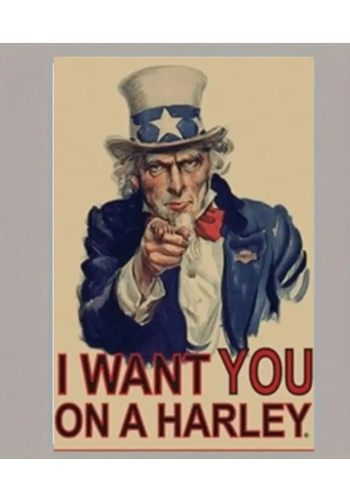I Want You On A Harley Metal Sign
A Call to Freedom: Decoding the "I Want You on a Harley" Sign
This image presents a digitally rendered, vintage-style sign featuring a reimagined Uncle Sam, his iconic visage repurposed for a modern call to adventure: "I WANT YOU ON A HARLEY." The sign's composition, color palette, and stylistic choices all contribute to a compelling visual narrative that blends historical iconography with contemporary cultural references, inviting the viewer to contemplate themes of patriotism, rebellion, and the open road.
The Sign's Composition: A Familiar Framework with a Twist
The sign's composition is immediately recognizable, drawing heavily from the iconic "I Want You for U.S. Army" recruitment poster created by James Montgomery Flagg during World War I. The central figure, Uncle Sam, occupies a dominant position, his piercing gaze and outstretched finger directly confronting the viewer. This familiar composition, deeply ingrained in the American psyche, instantly establishes a sense of authority and urgency.
However, the sign deviates from its historical predecessor in a significant way: the message. Instead of calling for military service, Uncle Sam now beckons the viewer to embrace the freedom and exhilaration of riding a Harley-Davidson motorcycle. This subtle yet powerful shift in message transforms the sign from a symbol of national duty to an emblem of personal liberation.
The text, "I WANT YOU ON A HARLEY," is presented in bold, sans-serif lettering, reminiscent of the original poster's typography. The use of a strong, assertive font reinforces the message's directness, echoing Uncle Sam's commanding presence. The placement of the text beneath the figure, within a rectangular border, further emphasizes its importance, ensuring that the message is clearly visible and easily digestible.
Uncle Sam: A Reimagined Icon
Uncle Sam, the quintessential symbol of American patriotism, is rendered with a blend of historical accuracy and contemporary interpretation. His attire, a dark blue jacket, white shirt, and red bow tie, remains faithful to the original depiction. However, his facial features and expression have been subtly altered to convey a more approachable and inviting demeanor.
His eyes, while still piercing, possess a hint of warmth, suggesting a genuine desire to connect with the viewer. His lips, slightly parted, seem to be on the verge of a smile, further softening his authoritative image. These subtle changes transform Uncle Sam from a stern recruiter to a charismatic advocate for freedom and adventure.
The addition of a star-spangled top hat, adorned with a blue band and white stars, reinforces his patriotic identity. However, the slightly tilted angle of the hat adds a touch of casualness, suggesting a more relaxed and unconventional interpretation of patriotism.
The Sign's Aesthetic: A Vintage Vibe with Modern Appeal
The sign's overall aesthetic is deliberately vintage, evoking the look and feel of a classic advertisement from the mid-20th century. The muted color palette, dominated by beige, blue, red, and white, contributes to this nostalgic feel, creating a sense of timelessness.
The use of a slightly distressed texture, reminiscent of aged paper or weathered metal, further enhances the sign's vintage appeal. This deliberate imperfection lends the image a sense of authenticity, suggesting a history and a story beyond the surface.
The sign's digital rendering, while mimicking the appearance of a vintage object, also highlights the role of technology in shaping contemporary culture. The use of digital tools allows for the creation of images that seamlessly blend elements of the past and the present, creating a unique visual language that resonates with a contemporary audience.
Interpretation and Cultural Context
The "I WANT YOU ON A HARLEY" sign can be interpreted in various ways, depending on the viewer's cultural background and personal experiences. For some, it may be seen as a celebration of American individualism and the open road, a call to embrace the freedom and adventure that Harley-Davidson motorcycles represent. For others, it may be viewed as a humorous and irreverent take on patriotism, a playful subversion of a national icon.
The sign's message also resonates with the enduring appeal of the Harley-Davidson brand, which has long been associated with rebellion, independence, and the American spirit. By placing Uncle Sam on a Harley, the sign effectively merges the brand's iconic imagery with the symbols of national identity, creating a powerful and memorable visual statement.
The sign's vintage aesthetic and patriotic imagery also evoke a sense of nostalgia for a bygone era, a time often romanticized as a period of American prosperity and optimism. This nostalgia, however, is not without its complexities. The sign's message, while seemingly apolitical, can also be interpreted as a subtle commentary on contemporary American culture, suggesting a yearning for a simpler time when the promise of freedom and adventure seemed more attainable.
Conclusion: A Symbol of Freedom and Adventure
In conclusion, the "I WANT YOU ON A HARLEY" sign is a compelling visual narrative that blends historical iconography with contemporary cultural references. Its familiar composition, reimagined Uncle Sam, and vintage aesthetic all contribute to a powerful message that resonates with themes of patriotism, rebellion, and the open road.
The sign serves as a reminder of the enduring power of iconic imagery, the ability of art to transcend its original context, and the ever-evolving relationship between national identity and popular culture. It's a testament to the enduring appeal of freedom and adventure, the allure of the open road, and the enduring legacy of Uncle Sam as a symbol of American identity. The sign, quite literally, calls to action, beckoning the viewer to embrace the spirit of independence and embark on their own personal journey of liberation. It's a sign that speaks to the heart of the American dream, a dream that continues to inspire and captivate generations.



